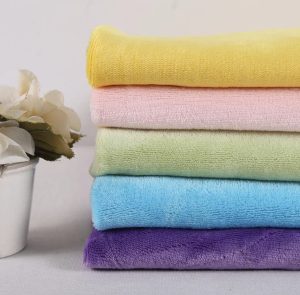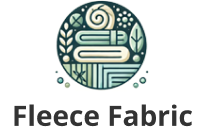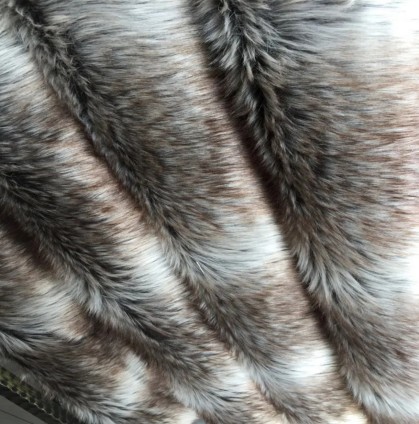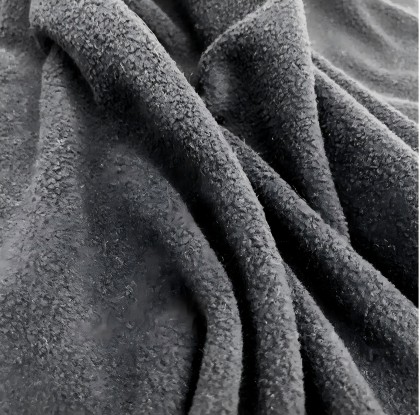Warm, soft, lightweight, easy to care for – if you’re looking for the ideal blanket to keep in your home or car, the best fleece fabric for blankets should be at the top of your list. But when you hit the stores, you quickly learn it’s not all one fleece. Polar fleece to microfleece, coral fleece to Sherpa – the options are many.
What’s the catch? What distinguishes one as better than the other for a specific application— snuggling on the couch, camping, or even as a DIY throw for someone?
So Why Fleece for Blankets?
Before we break down the specific differences between various types of fleece fabrics, let’s first take a moment to appreciate why fleece is such a popular fabric for blankets:
- Fleece is a man-made product, typically produced from various polyester fibers.
- When initially developed, its main purpose was to replicate the warmth of wool, minus the weight and itchiness, and with reduced care requirements.
- Nowadays, it’s mainly known for being:
- Soft and luxurious to touch
- Efficient at insulating
- Lightweight and airy
- Quick to dry and moisture-wicking
- Anti-allergenic and simple to care for
These advantages have seen fleece become one of the most popular materials for throw blankets, baby wraps, and camping gear, as well as home décor and pet beds.
However, all fleeces are not equal. The subsequent sections will help you understand how to compare and choose the right one.

Key Features to Observe When Selecting Fleece for Blankets
The following considerations are crucial in selecting the best fleece fabric for blankets:
1. Softness
Breathability is not a property typically associated with fleece since double-brushed and Sherpa fleece both have closely knitted weaves that block wind from passing through and water from seeping in. This limits their circulation around the skin when used as blankets. Quality fleece should retain heat but still breathe. Higher-end fleece fabrics get the proportions right between insulation and airing.
GSM:
GSM stands for grams per square meter, and it indicates fabric weight as well as density:
- 150-200 GSM: Light weights, Fine for summer or indoor conditions
- 200-300 GSM: Mid-weight, Versatile for most environments
- 300+ GSM: Heavy, Excellent for winter or outdoor settings
Durability
Regular use and laundering should be performed on fleece blankets. To avoid fuzzy balls after washing, fleece blankets may be anti-pill.
6. Moisture-Wicking
Fleece isn’t absorbent like cotton. Instead, it wicks moisture away from the skin, promoting warmth and dryness – a valuable characteristic for outdoor wear or baby blankets.
7. Hypoallergenic Properties
People with sensitive skin or allergies will find fleece (particularly microfleece) much preferable to wool or down.
Types of Fleece Material for Blankets
Now, let us consider in more detail which fleece fabrics are the most popular and functional in the production of blankets, and in what cases they should be chosen.
1. Polar Fleece
Polar fleece is the ‘classic all-rounder’, and universal choice. It’s created from 100% polyester, and is thick and warm, generally brushed on both sides for added softness.
Recommended for: Winter blankets, pet throws, blankets for a couch
Advantages: Warm, insulated, inexpensive, quick drying
Cons: Pills with time, slightly less breathable than previous styles due to the extra layering in these particular ones
2. Microfleece
Microfleece is finer and lighter than polar fleece, which works when bulk is the last thing wanted.
Best for: Baby blankets, travel throws, warm-weather use
Pros: Lightweight, super silky soft, extremely breathable, moisture-wicking
Cons: Less warm than thicker fleece due to its thin texture
3. Sherpa Fleece
Sherpa fleece has one side brushed to a wool-like texture, with the other smooth knitted. Commonly used as lining or in ultra-warm, luxurious blankets.
Ideal For: As cozy throws, reversible blankets, Bedding for the Winter season
Pros: Incredibly warm, soft, and elegant look
Cons: Heavier; bulkier; often more expensive
4. Coral Fleece
A ‘coral’ fleece – named so because of the velvety nap and dense pile, which makes it feel very much like mink or velvet; one of the softest textiles available.
Best for: Luxury blankets, children’s bedding, in a spa setting
Pros: Very soft, bright color options, great look
Cons: May be slippery and not very breathable at times
5. Blizzard Fleece
A closely knit polar fleece fabric, Blizzard fleece is often used for no-sew craft blanket projects because of its structure and bold patterns.
Best for: Craft blankets, throws for decoration, and giving as a gift
Pros: Good structure, holds prints very well, easy to cut
Cons: Shrinks if not pre-washed; anti-static
6. Anti-Pill Fleece
Certain fleece, engineered not to pill, keeps its good looks longer through multiple washes after anti-pill fleece.
Best for: Regular wash and wear or machine-washable blankets
Pros: Long-lasting and low maintenance, smooth
Cons: Slightly higher cost, not quite as soft initially

Best Types of Fleece for Different Blanket Needs
| Use | Recommended Fleece | Why? |
|---|---|---|
| Daily sofa use | Anti-pill, Polar | They are warm and comfortable and can be convenient to use for the daily sofa. |
| Baby Blankets | Microfleece, Coral | Very soft for a baby’s sensitive skin |
| Luxury Home Decor | Sherpa, Coral | Elegant, soft, and appealing to the eye |
| DIY Craft Blankets | Blizzard | Excellent for cutting and great for tying |
| Outdoor Camping | Polar, Anti-pill | Warm and naturally water-repellent |
| Cold-Weather Bedding | Sherpa, Heavy Polar | Highest insulation as well as bulk |
| Travel Blanket | Microfleece | Lightweight and can be packed efficiently |
Fleece vs. Other Blanket Material
| Blanket Material | Warmth | Weight | Maintenance | Softness | Allergy | Cost |
|---|---|---|---|---|---|---|
| Fleece | Excellent | Lightweight | Easy | Very soft | Mostly yes | Affordable |
| Cotton | Moderate | Medium | May shrink | Soft | Yes | Affordable |
| Wool | Excellent | Heavy | Delicate care | Itchy sometimes | Sometimes not | Expensive |
| Flannel | Good | Medium | Moderate | Easy | Good |
How to Recognize Quality Fleece Fabric
- Stretch and Recovery: Premium fleece that stretches but recovers without sagging.
- Brushed Surface: Double-brushed for total softness.
- Tight Knit: A tighter-knit fabric that ensures less pilling and a longer lifespan.
- GSM Rating: Check the weight. Over 250 GSM is warm.
- Anti-Pill Label: REALLY Pill Resistant; for a neater look and durability over time.
Eco-Friendly Fleece Options
Fleece is generally purchased as polyester (a crude oil product), however, there are now recycled fleece fabrics available made from post-consumer recycled plastic soda bottles.
More valuable are:
- GRS (Global Recycle Standard) certified fleece
- Brands that are sustainable practitioners
- ‘Recycled content’ specification
By choosing these options, the impact of the environment can be lessened while maintaining the same comfort.
How to Care for Fleece Blankets
- Wash cold: Hot water can wreak havoc on synthetic fibers.
- Use mild detergent, not bleach or fabric softeners.
- High heat drying must be avoided, tumble dry at low heat, or air dry it, since it will melt.
- Do not iron fleece; it will scorch or melt under direct heat.
- Store in areas with no moisture and that are cool and dry as well, and avoid the sun since it may cause fading.
Popular Brands Offering the Best Fleece Blankets
- Bedsure – Coral and Sherpa fleece, which are affordable and easily accessible
- Pendleton – Premium fleece throws with native-inspired patterns
- L.L. Bean – Durable fleece blankets to keep indoors or for outdoor use
- Ugg – Luxe Sherpa lined and ultra-soft fleece for the home
- Target/Threshold Line – Budget-friendly, trendy design fleece
Final Thoughts: How to Choose the Best Fleece Fabric for Blankets
Picking the right fleece fabric for the blanket is all about what your main need is: warmth, softness, aesthetics, or functionality. Here’s a quick recap:
- Sherpa or Heavy Polar Fleece: For maximum warmth
- Coral Fleece or Microfleece: For the softest touch
- Anti-pill Fleece: For long-term use
- Blizzard Fleece: For DIY fun
- Recycled fleece fabrics: For eco-conscious buyers
Regardless of the purpose, the correct fleece will give unmatched comfort, performance, and value; thus, it’s more than just a household item but a warm companion through every season. If you are looking for the Best Fleece Fabric for Blankets, feel free to contact us.




